Strategic Approaches to Human Resource Management Analysis
VerifiedAdded on 2022/12/15
|11
|3111
|55
Report
AI Summary
This report provides a comprehensive overview of strategic approaches to Human Resource Management (HRM). It begins by defining the evolving role of HRM, emphasizing its shift towards strategic alignment with organizational objectives, including recruitment, training, and performance management within organizations like Hilton Hotel. The report then delves into techniques for planning business and HR strategies, covering topics such as assessing current HR capacity, forecasting HR requirements, and utilizing tools like the HRM matrix and employer branding. Furthermore, it explores how HRM systems contribute to sustained competitive advantage through the development of firm-specific competencies, complex social relationships, and organizational knowledge. The report also examines high-performance work practices and their impact on organizational performance, emphasizing the importance of employee skills, motivation, and opportunity in achieving competitive advantages and financial gains.
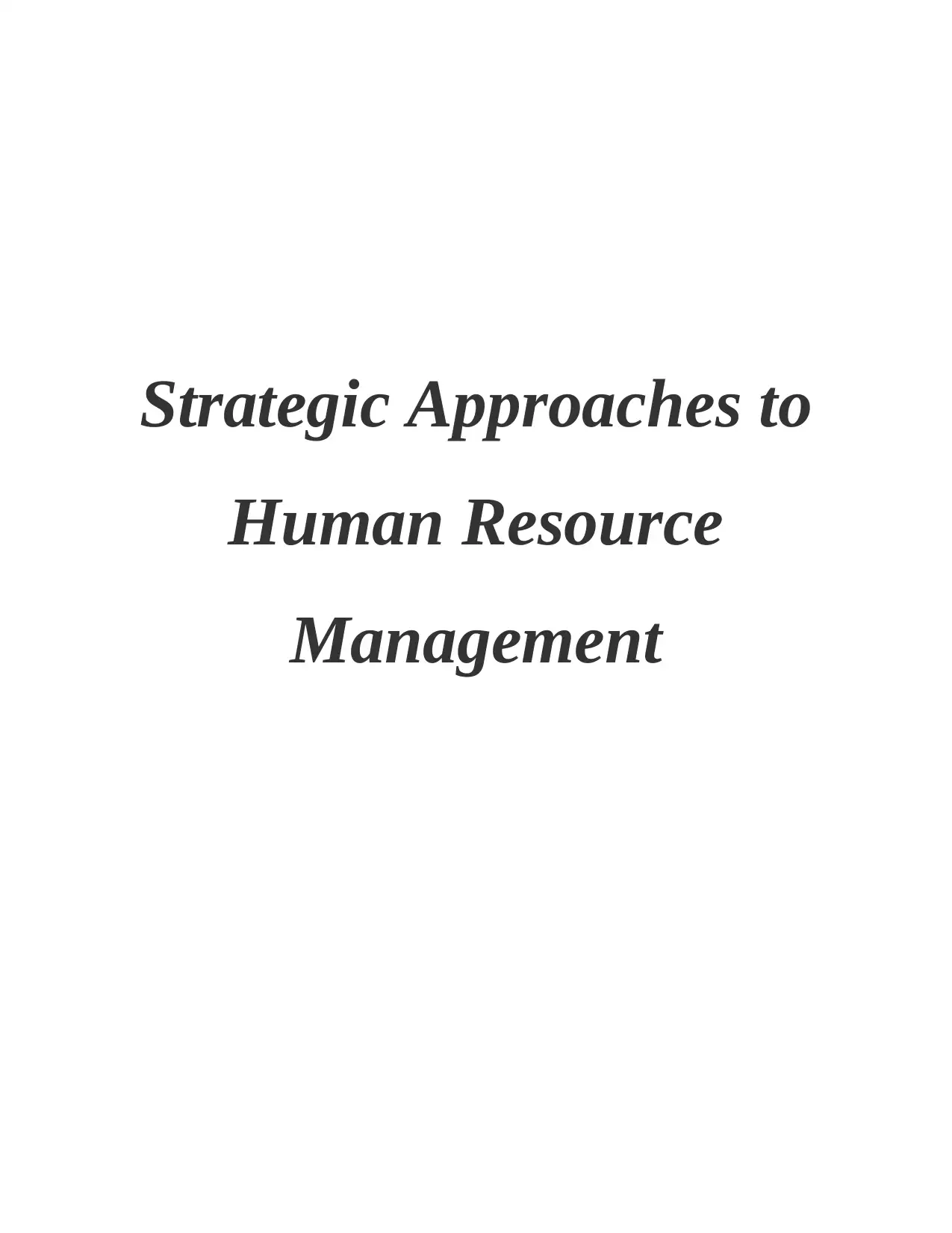
Strategic Approaches to
Human Resource
Management
Human Resource
Management
Paraphrase This Document
Need a fresh take? Get an instant paraphrase of this document with our AI Paraphraser
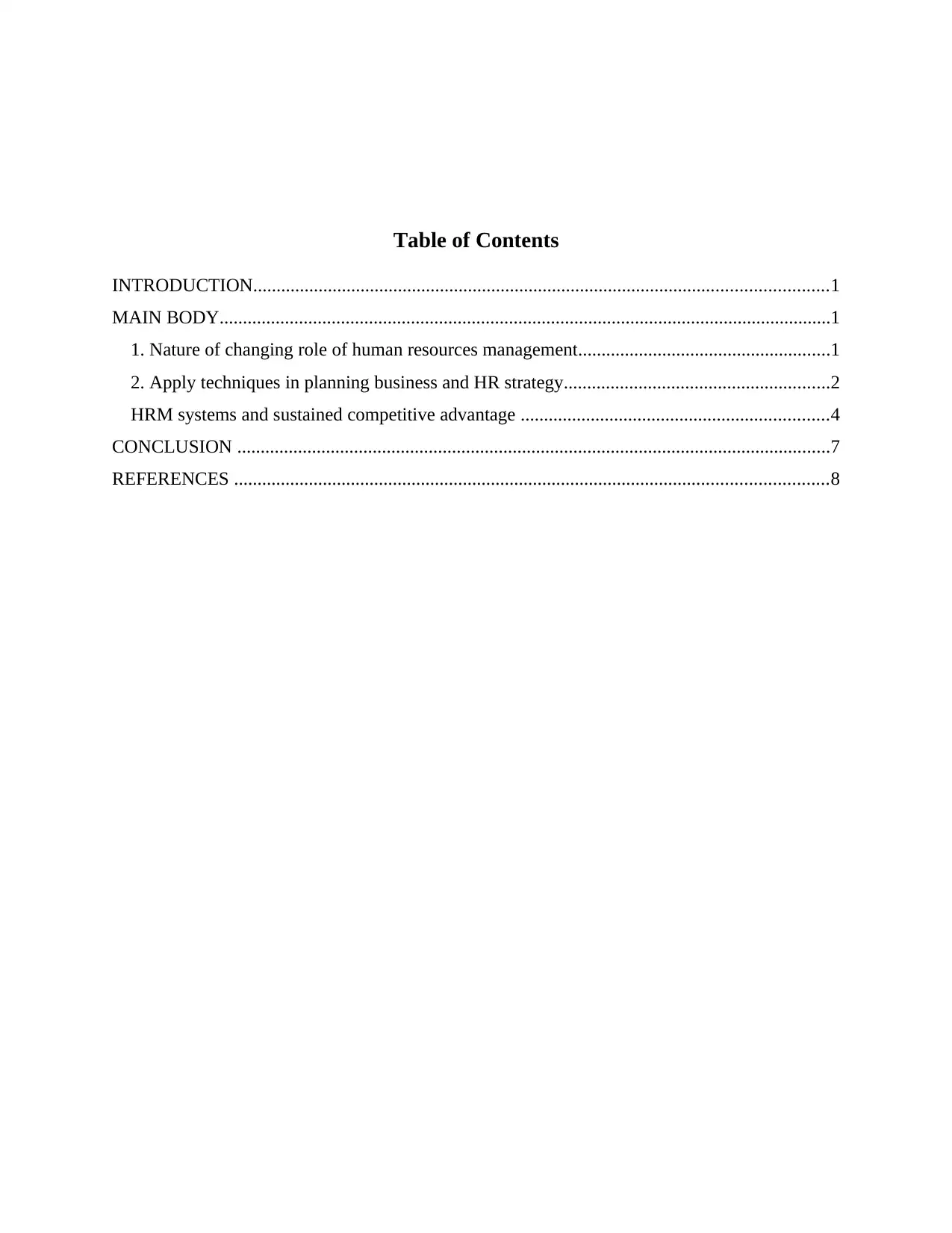
Table of Contents
INTRODUCTION...........................................................................................................................1
MAIN BODY...................................................................................................................................1
1. Nature of changing role of human resources management......................................................1
2. Apply techniques in planning business and HR strategy.........................................................2
HRM systems and sustained competitive advantage ..................................................................4
CONCLUSION ...............................................................................................................................7
REFERENCES ...............................................................................................................................8
INTRODUCTION...........................................................................................................................1
MAIN BODY...................................................................................................................................1
1. Nature of changing role of human resources management......................................................1
2. Apply techniques in planning business and HR strategy.........................................................2
HRM systems and sustained competitive advantage ..................................................................4
CONCLUSION ...............................................................................................................................7
REFERENCES ...............................................................................................................................8

⊘ This is a preview!⊘
Do you want full access?
Subscribe today to unlock all pages.

Trusted by 1+ million students worldwide
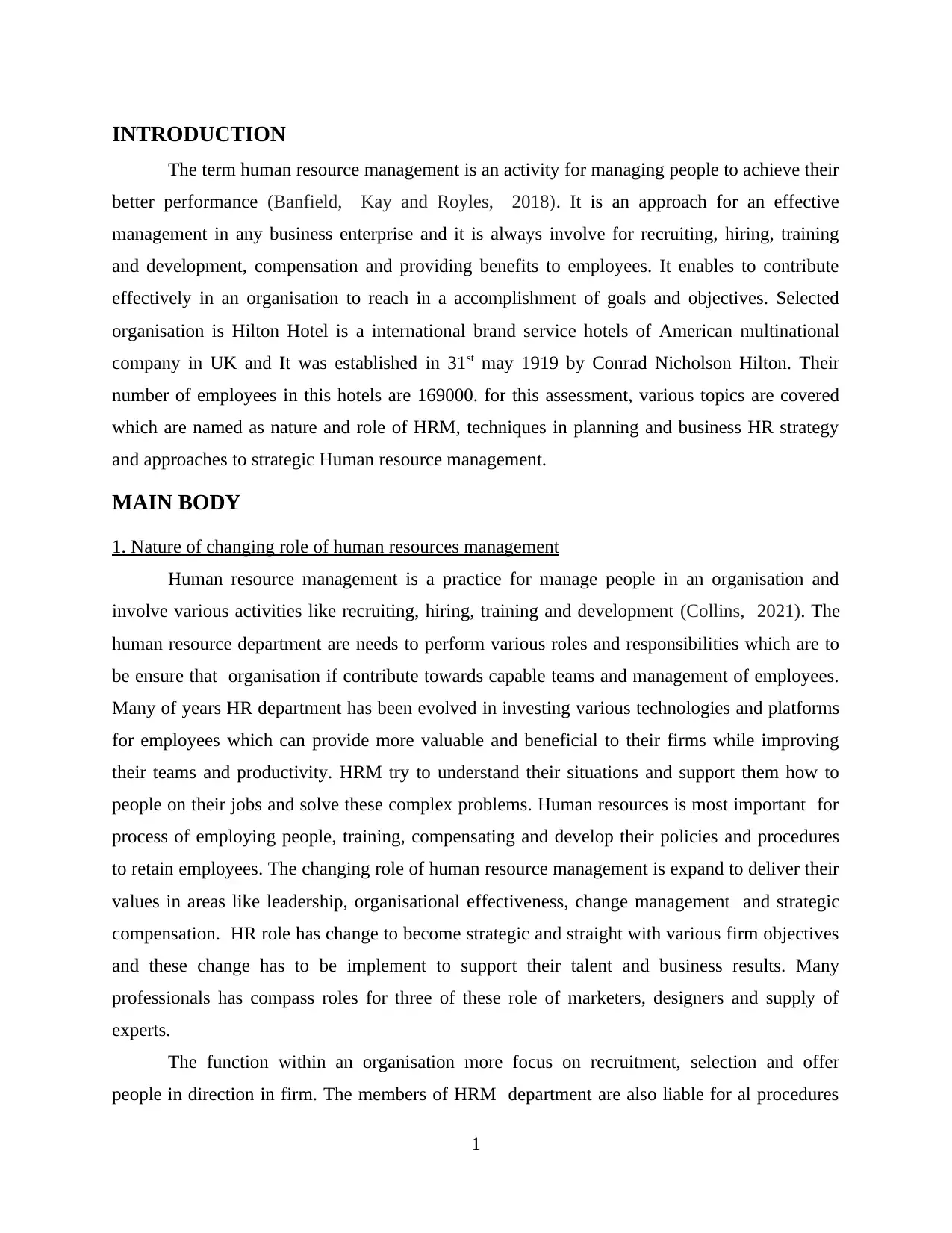
INTRODUCTION
The term human resource management is an activity for managing people to achieve their
better performance (Banfield, Kay and Royles, 2018). It is an approach for an effective
management in any business enterprise and it is always involve for recruiting, hiring, training
and development, compensation and providing benefits to employees. It enables to contribute
effectively in an organisation to reach in a accomplishment of goals and objectives. Selected
organisation is Hilton Hotel is a international brand service hotels of American multinational
company in UK and It was established in 31st may 1919 by Conrad Nicholson Hilton. Their
number of employees in this hotels are 169000. for this assessment, various topics are covered
which are named as nature and role of HRM, techniques in planning and business HR strategy
and approaches to strategic Human resource management.
MAIN BODY
1. Nature of changing role of human resources management
Human resource management is a practice for manage people in an organisation and
involve various activities like recruiting, hiring, training and development (Collins, 2021). The
human resource department are needs to perform various roles and responsibilities which are to
be ensure that organisation if contribute towards capable teams and management of employees.
Many of years HR department has been evolved in investing various technologies and platforms
for employees which can provide more valuable and beneficial to their firms while improving
their teams and productivity. HRM try to understand their situations and support them how to
people on their jobs and solve these complex problems. Human resources is most important for
process of employing people, training, compensating and develop their policies and procedures
to retain employees. The changing role of human resource management is expand to deliver their
values in areas like leadership, organisational effectiveness, change management and strategic
compensation. HR role has change to become strategic and straight with various firm objectives
and these change has to be implement to support their talent and business results. Many
professionals has compass roles for three of these role of marketers, designers and supply of
experts.
The function within an organisation more focus on recruitment, selection and offer
people in direction in firm. The members of HRM department are also liable for al procedures
1
The term human resource management is an activity for managing people to achieve their
better performance (Banfield, Kay and Royles, 2018). It is an approach for an effective
management in any business enterprise and it is always involve for recruiting, hiring, training
and development, compensation and providing benefits to employees. It enables to contribute
effectively in an organisation to reach in a accomplishment of goals and objectives. Selected
organisation is Hilton Hotel is a international brand service hotels of American multinational
company in UK and It was established in 31st may 1919 by Conrad Nicholson Hilton. Their
number of employees in this hotels are 169000. for this assessment, various topics are covered
which are named as nature and role of HRM, techniques in planning and business HR strategy
and approaches to strategic Human resource management.
MAIN BODY
1. Nature of changing role of human resources management
Human resource management is a practice for manage people in an organisation and
involve various activities like recruiting, hiring, training and development (Collins, 2021). The
human resource department are needs to perform various roles and responsibilities which are to
be ensure that organisation if contribute towards capable teams and management of employees.
Many of years HR department has been evolved in investing various technologies and platforms
for employees which can provide more valuable and beneficial to their firms while improving
their teams and productivity. HRM try to understand their situations and support them how to
people on their jobs and solve these complex problems. Human resources is most important for
process of employing people, training, compensating and develop their policies and procedures
to retain employees. The changing role of human resource management is expand to deliver their
values in areas like leadership, organisational effectiveness, change management and strategic
compensation. HR role has change to become strategic and straight with various firm objectives
and these change has to be implement to support their talent and business results. Many
professionals has compass roles for three of these role of marketers, designers and supply of
experts.
The function within an organisation more focus on recruitment, selection and offer
people in direction in firm. The members of HRM department are also liable for al procedures
1
Paraphrase This Document
Need a fresh take? Get an instant paraphrase of this document with our AI Paraphraser
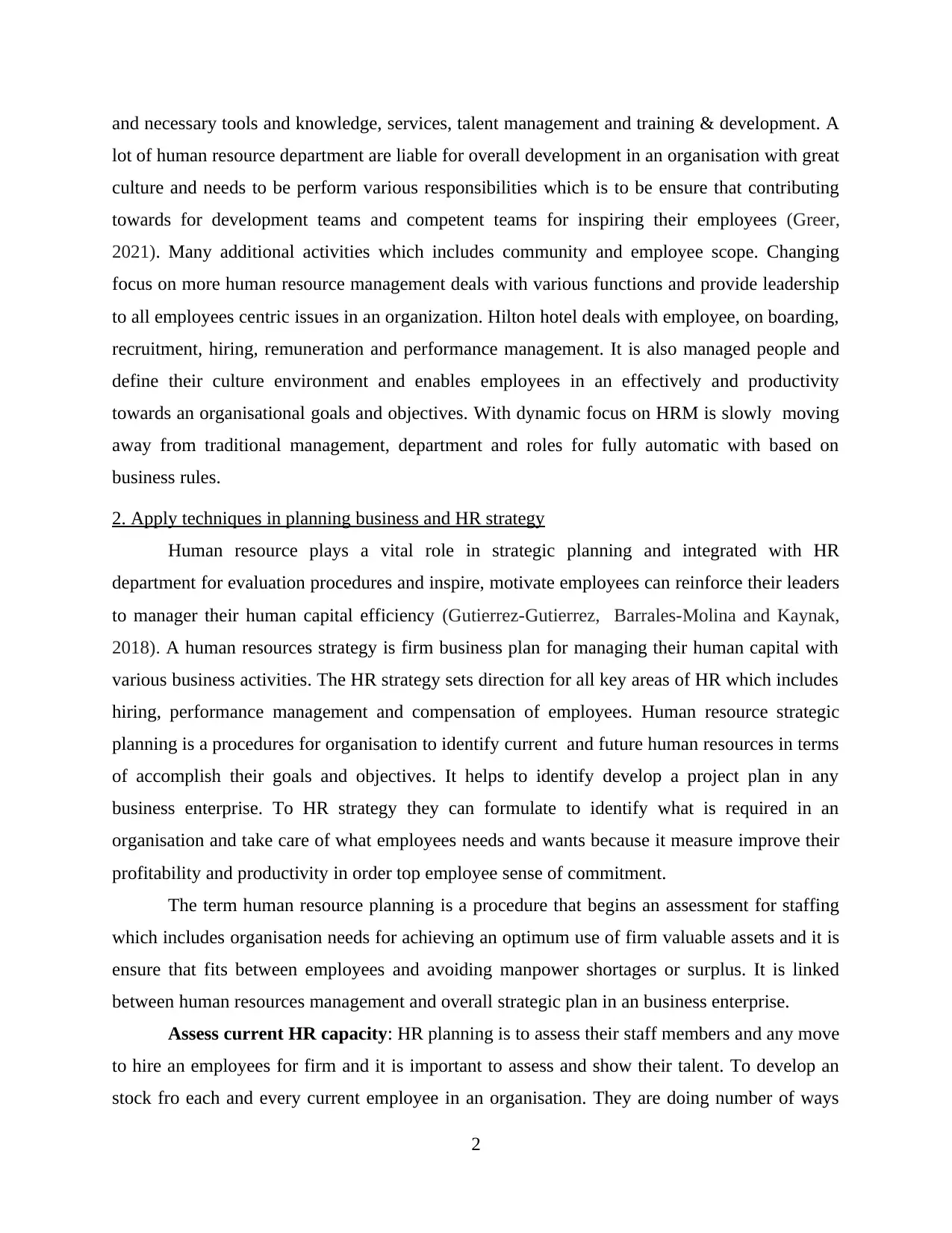
and necessary tools and knowledge, services, talent management and training & development. A
lot of human resource department are liable for overall development in an organisation with great
culture and needs to be perform various responsibilities which is to be ensure that contributing
towards for development teams and competent teams for inspiring their employees (Greer,
2021). Many additional activities which includes community and employee scope. Changing
focus on more human resource management deals with various functions and provide leadership
to all employees centric issues in an organization. Hilton hotel deals with employee, on boarding,
recruitment, hiring, remuneration and performance management. It is also managed people and
define their culture environment and enables employees in an effectively and productivity
towards an organisational goals and objectives. With dynamic focus on HRM is slowly moving
away from traditional management, department and roles for fully automatic with based on
business rules.
2. Apply techniques in planning business and HR strategy
Human resource plays a vital role in strategic planning and integrated with HR
department for evaluation procedures and inspire, motivate employees can reinforce their leaders
to manager their human capital efficiency (Gutierrez-Gutierrez, Barrales-Molina and Kaynak,
2018). A human resources strategy is firm business plan for managing their human capital with
various business activities. The HR strategy sets direction for all key areas of HR which includes
hiring, performance management and compensation of employees. Human resource strategic
planning is a procedures for organisation to identify current and future human resources in terms
of accomplish their goals and objectives. It helps to identify develop a project plan in any
business enterprise. To HR strategy they can formulate to identify what is required in an
organisation and take care of what employees needs and wants because it measure improve their
profitability and productivity in order top employee sense of commitment.
The term human resource planning is a procedure that begins an assessment for staffing
which includes organisation needs for achieving an optimum use of firm valuable assets and it is
ensure that fits between employees and avoiding manpower shortages or surplus. It is linked
between human resources management and overall strategic plan in an business enterprise.
Assess current HR capacity: HR planning is to assess their staff members and any move
to hire an employees for firm and it is important to assess and show their talent. To develop an
stock fro each and every current employee in an organisation. They are doing number of ways
2
lot of human resource department are liable for overall development in an organisation with great
culture and needs to be perform various responsibilities which is to be ensure that contributing
towards for development teams and competent teams for inspiring their employees (Greer,
2021). Many additional activities which includes community and employee scope. Changing
focus on more human resource management deals with various functions and provide leadership
to all employees centric issues in an organization. Hilton hotel deals with employee, on boarding,
recruitment, hiring, remuneration and performance management. It is also managed people and
define their culture environment and enables employees in an effectively and productivity
towards an organisational goals and objectives. With dynamic focus on HRM is slowly moving
away from traditional management, department and roles for fully automatic with based on
business rules.
2. Apply techniques in planning business and HR strategy
Human resource plays a vital role in strategic planning and integrated with HR
department for evaluation procedures and inspire, motivate employees can reinforce their leaders
to manager their human capital efficiency (Gutierrez-Gutierrez, Barrales-Molina and Kaynak,
2018). A human resources strategy is firm business plan for managing their human capital with
various business activities. The HR strategy sets direction for all key areas of HR which includes
hiring, performance management and compensation of employees. Human resource strategic
planning is a procedures for organisation to identify current and future human resources in terms
of accomplish their goals and objectives. It helps to identify develop a project plan in any
business enterprise. To HR strategy they can formulate to identify what is required in an
organisation and take care of what employees needs and wants because it measure improve their
profitability and productivity in order top employee sense of commitment.
The term human resource planning is a procedure that begins an assessment for staffing
which includes organisation needs for achieving an optimum use of firm valuable assets and it is
ensure that fits between employees and avoiding manpower shortages or surplus. It is linked
between human resources management and overall strategic plan in an business enterprise.
Assess current HR capacity: HR planning is to assess their staff members and any move
to hire an employees for firm and it is important to assess and show their talent. To develop an
stock fro each and every current employee in an organisation. They are doing number of ways
2
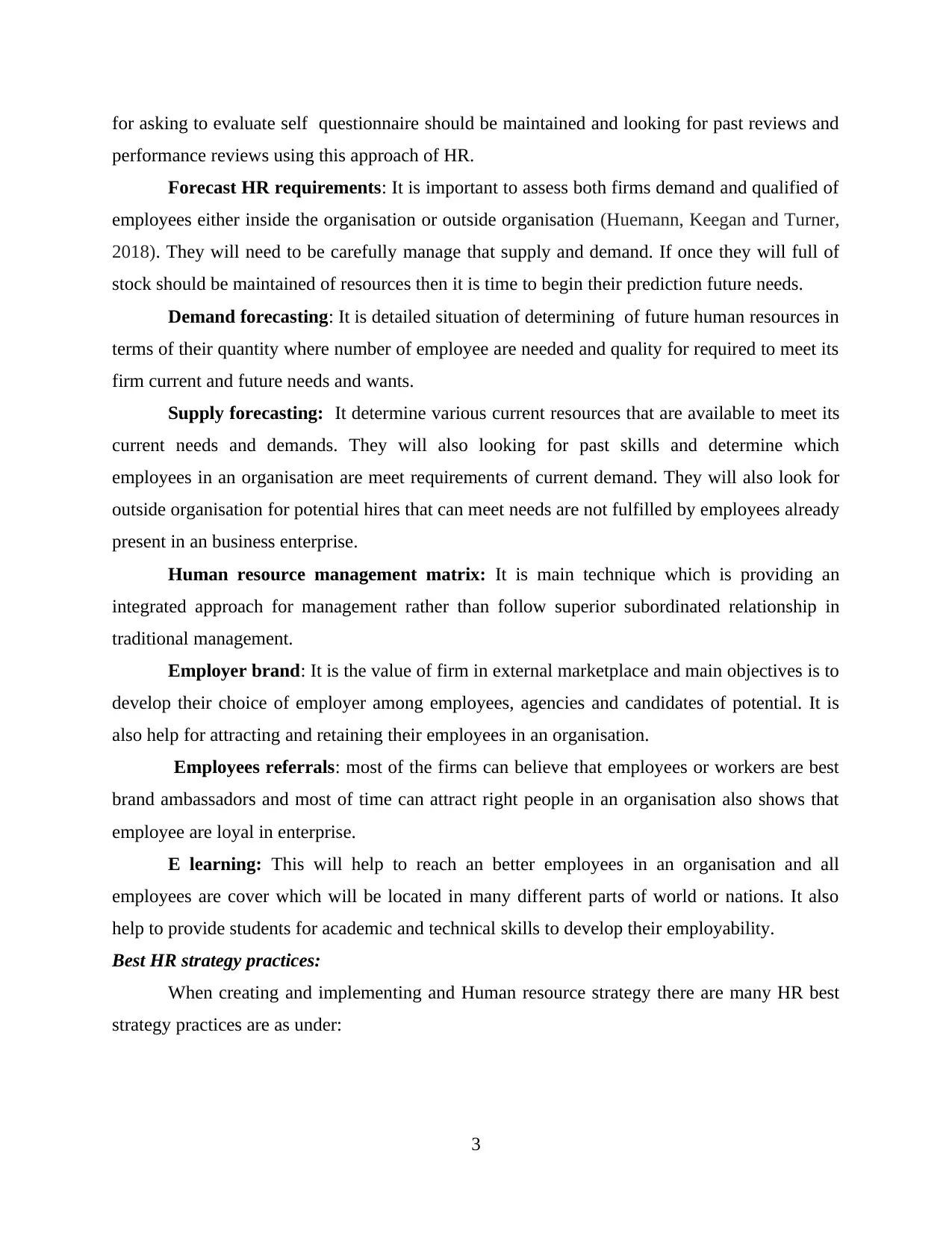
for asking to evaluate self questionnaire should be maintained and looking for past reviews and
performance reviews using this approach of HR.
Forecast HR requirements: It is important to assess both firms demand and qualified of
employees either inside the organisation or outside organisation (Huemann, Keegan and Turner,
2018). They will need to be carefully manage that supply and demand. If once they will full of
stock should be maintained of resources then it is time to begin their prediction future needs.
Demand forecasting: It is detailed situation of determining of future human resources in
terms of their quantity where number of employee are needed and quality for required to meet its
firm current and future needs and wants.
Supply forecasting: It determine various current resources that are available to meet its
current needs and demands. They will also looking for past skills and determine which
employees in an organisation are meet requirements of current demand. They will also look for
outside organisation for potential hires that can meet needs are not fulfilled by employees already
present in an business enterprise.
Human resource management matrix: It is main technique which is providing an
integrated approach for management rather than follow superior subordinated relationship in
traditional management.
Employer brand: It is the value of firm in external marketplace and main objectives is to
develop their choice of employer among employees, agencies and candidates of potential. It is
also help for attracting and retaining their employees in an organisation.
Employees referrals: most of the firms can believe that employees or workers are best
brand ambassadors and most of time can attract right people in an organisation also shows that
employee are loyal in enterprise.
E learning: This will help to reach an better employees in an organisation and all
employees are cover which will be located in many different parts of world or nations. It also
help to provide students for academic and technical skills to develop their employability.
Best HR strategy practices:
When creating and implementing and Human resource strategy there are many HR best
strategy practices are as under:
3
performance reviews using this approach of HR.
Forecast HR requirements: It is important to assess both firms demand and qualified of
employees either inside the organisation or outside organisation (Huemann, Keegan and Turner,
2018). They will need to be carefully manage that supply and demand. If once they will full of
stock should be maintained of resources then it is time to begin their prediction future needs.
Demand forecasting: It is detailed situation of determining of future human resources in
terms of their quantity where number of employee are needed and quality for required to meet its
firm current and future needs and wants.
Supply forecasting: It determine various current resources that are available to meet its
current needs and demands. They will also looking for past skills and determine which
employees in an organisation are meet requirements of current demand. They will also look for
outside organisation for potential hires that can meet needs are not fulfilled by employees already
present in an business enterprise.
Human resource management matrix: It is main technique which is providing an
integrated approach for management rather than follow superior subordinated relationship in
traditional management.
Employer brand: It is the value of firm in external marketplace and main objectives is to
develop their choice of employer among employees, agencies and candidates of potential. It is
also help for attracting and retaining their employees in an organisation.
Employees referrals: most of the firms can believe that employees or workers are best
brand ambassadors and most of time can attract right people in an organisation also shows that
employee are loyal in enterprise.
E learning: This will help to reach an better employees in an organisation and all
employees are cover which will be located in many different parts of world or nations. It also
help to provide students for academic and technical skills to develop their employability.
Best HR strategy practices:
When creating and implementing and Human resource strategy there are many HR best
strategy practices are as under:
3
⊘ This is a preview!⊘
Do you want full access?
Subscribe today to unlock all pages.

Trusted by 1+ million students worldwide
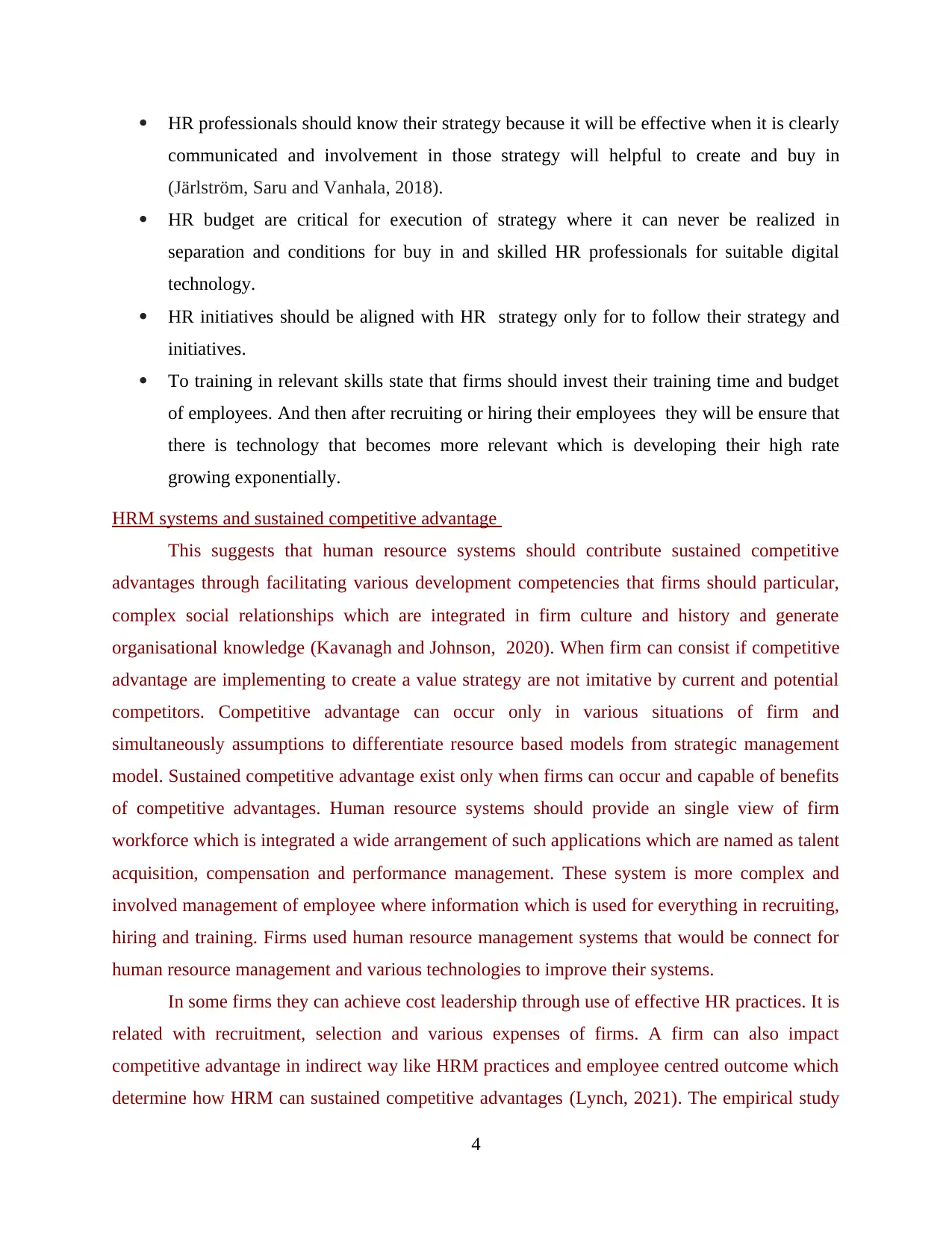
HR professionals should know their strategy because it will be effective when it is clearly
communicated and involvement in those strategy will helpful to create and buy in
(Järlström, Saru and Vanhala, 2018).
HR budget are critical for execution of strategy where it can never be realized in
separation and conditions for buy in and skilled HR professionals for suitable digital
technology.
HR initiatives should be aligned with HR strategy only for to follow their strategy and
initiatives.
To training in relevant skills state that firms should invest their training time and budget
of employees. And then after recruiting or hiring their employees they will be ensure that
there is technology that becomes more relevant which is developing their high rate
growing exponentially.
HRM systems and sustained competitive advantage
This suggests that human resource systems should contribute sustained competitive
advantages through facilitating various development competencies that firms should particular,
complex social relationships which are integrated in firm culture and history and generate
organisational knowledge (Kavanagh and Johnson, 2020). When firm can consist if competitive
advantage are implementing to create a value strategy are not imitative by current and potential
competitors. Competitive advantage can occur only in various situations of firm and
simultaneously assumptions to differentiate resource based models from strategic management
model. Sustained competitive advantage exist only when firms can occur and capable of benefits
of competitive advantages. Human resource systems should provide an single view of firm
workforce which is integrated a wide arrangement of such applications which are named as talent
acquisition, compensation and performance management. These system is more complex and
involved management of employee where information which is used for everything in recruiting,
hiring and training. Firms used human resource management systems that would be connect for
human resource management and various technologies to improve their systems.
In some firms they can achieve cost leadership through use of effective HR practices. It is
related with recruitment, selection and various expenses of firms. A firm can also impact
competitive advantage in indirect way like HRM practices and employee centred outcome which
determine how HRM can sustained competitive advantages (Lynch, 2021). The empirical study
4
communicated and involvement in those strategy will helpful to create and buy in
(Järlström, Saru and Vanhala, 2018).
HR budget are critical for execution of strategy where it can never be realized in
separation and conditions for buy in and skilled HR professionals for suitable digital
technology.
HR initiatives should be aligned with HR strategy only for to follow their strategy and
initiatives.
To training in relevant skills state that firms should invest their training time and budget
of employees. And then after recruiting or hiring their employees they will be ensure that
there is technology that becomes more relevant which is developing their high rate
growing exponentially.
HRM systems and sustained competitive advantage
This suggests that human resource systems should contribute sustained competitive
advantages through facilitating various development competencies that firms should particular,
complex social relationships which are integrated in firm culture and history and generate
organisational knowledge (Kavanagh and Johnson, 2020). When firm can consist if competitive
advantage are implementing to create a value strategy are not imitative by current and potential
competitors. Competitive advantage can occur only in various situations of firm and
simultaneously assumptions to differentiate resource based models from strategic management
model. Sustained competitive advantage exist only when firms can occur and capable of benefits
of competitive advantages. Human resource systems should provide an single view of firm
workforce which is integrated a wide arrangement of such applications which are named as talent
acquisition, compensation and performance management. These system is more complex and
involved management of employee where information which is used for everything in recruiting,
hiring and training. Firms used human resource management systems that would be connect for
human resource management and various technologies to improve their systems.
In some firms they can achieve cost leadership through use of effective HR practices. It is
related with recruitment, selection and various expenses of firms. A firm can also impact
competitive advantage in indirect way like HRM practices and employee centred outcome which
determine how HRM can sustained competitive advantages (Lynch, 2021). The empirical study
4
Paraphrase This Document
Need a fresh take? Get an instant paraphrase of this document with our AI Paraphraser
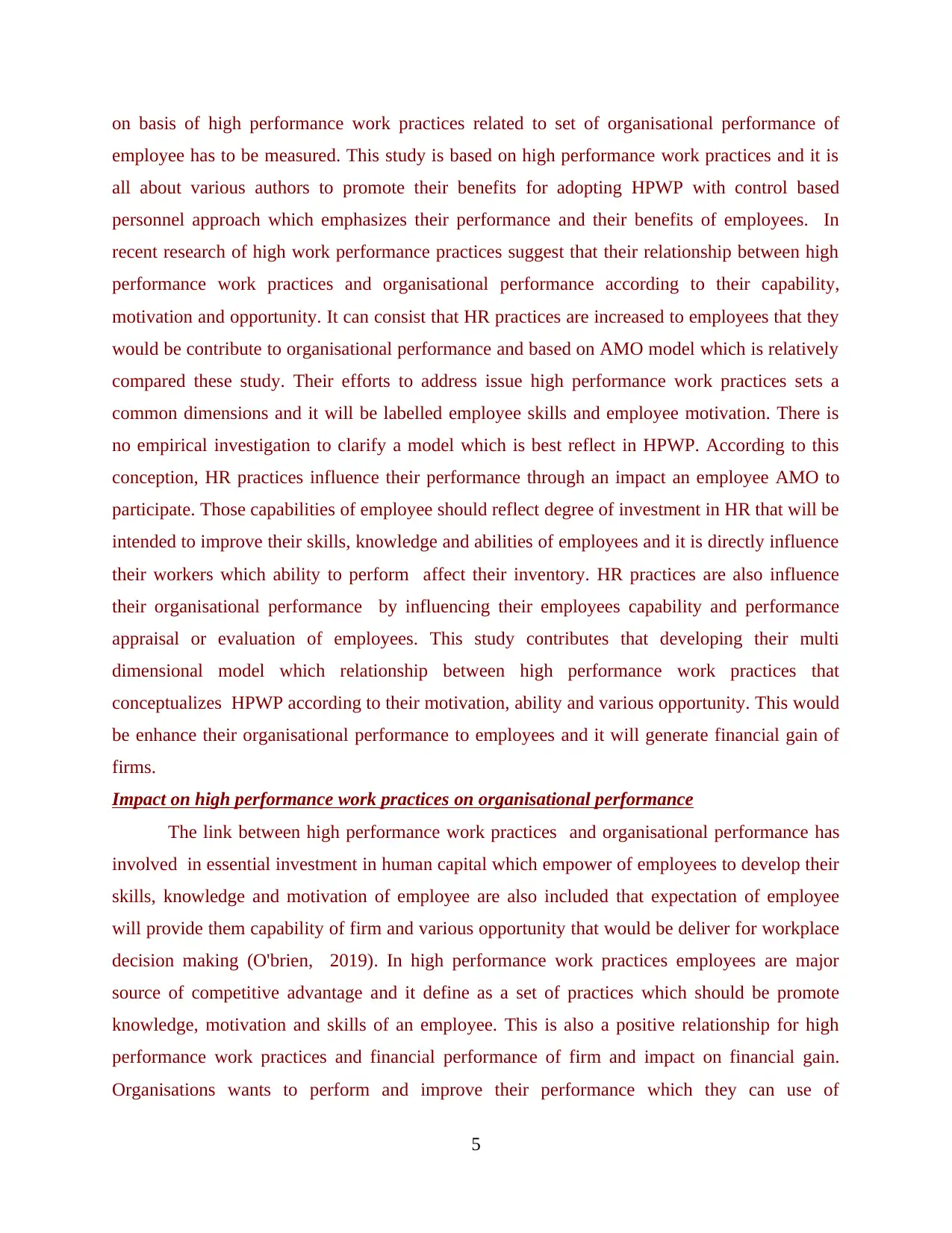
on basis of high performance work practices related to set of organisational performance of
employee has to be measured. This study is based on high performance work practices and it is
all about various authors to promote their benefits for adopting HPWP with control based
personnel approach which emphasizes their performance and their benefits of employees. In
recent research of high work performance practices suggest that their relationship between high
performance work practices and organisational performance according to their capability,
motivation and opportunity. It can consist that HR practices are increased to employees that they
would be contribute to organisational performance and based on AMO model which is relatively
compared these study. Their efforts to address issue high performance work practices sets a
common dimensions and it will be labelled employee skills and employee motivation. There is
no empirical investigation to clarify a model which is best reflect in HPWP. According to this
conception, HR practices influence their performance through an impact an employee AMO to
participate. Those capabilities of employee should reflect degree of investment in HR that will be
intended to improve their skills, knowledge and abilities of employees and it is directly influence
their workers which ability to perform affect their inventory. HR practices are also influence
their organisational performance by influencing their employees capability and performance
appraisal or evaluation of employees. This study contributes that developing their multi
dimensional model which relationship between high performance work practices that
conceptualizes HPWP according to their motivation, ability and various opportunity. This would
be enhance their organisational performance to employees and it will generate financial gain of
firms.
Impact on high performance work practices on organisational performance
The link between high performance work practices and organisational performance has
involved in essential investment in human capital which empower of employees to develop their
skills, knowledge and motivation of employee are also included that expectation of employee
will provide them capability of firm and various opportunity that would be deliver for workplace
decision making (O'brien, 2019). In high performance work practices employees are major
source of competitive advantage and it define as a set of practices which should be promote
knowledge, motivation and skills of an employee. This is also a positive relationship for high
performance work practices and financial performance of firm and impact on financial gain.
Organisations wants to perform and improve their performance which they can use of
5
employee has to be measured. This study is based on high performance work practices and it is
all about various authors to promote their benefits for adopting HPWP with control based
personnel approach which emphasizes their performance and their benefits of employees. In
recent research of high work performance practices suggest that their relationship between high
performance work practices and organisational performance according to their capability,
motivation and opportunity. It can consist that HR practices are increased to employees that they
would be contribute to organisational performance and based on AMO model which is relatively
compared these study. Their efforts to address issue high performance work practices sets a
common dimensions and it will be labelled employee skills and employee motivation. There is
no empirical investigation to clarify a model which is best reflect in HPWP. According to this
conception, HR practices influence their performance through an impact an employee AMO to
participate. Those capabilities of employee should reflect degree of investment in HR that will be
intended to improve their skills, knowledge and abilities of employees and it is directly influence
their workers which ability to perform affect their inventory. HR practices are also influence
their organisational performance by influencing their employees capability and performance
appraisal or evaluation of employees. This study contributes that developing their multi
dimensional model which relationship between high performance work practices that
conceptualizes HPWP according to their motivation, ability and various opportunity. This would
be enhance their organisational performance to employees and it will generate financial gain of
firms.
Impact on high performance work practices on organisational performance
The link between high performance work practices and organisational performance has
involved in essential investment in human capital which empower of employees to develop their
skills, knowledge and motivation of employee are also included that expectation of employee
will provide them capability of firm and various opportunity that would be deliver for workplace
decision making (O'brien, 2019). In high performance work practices employees are major
source of competitive advantage and it define as a set of practices which should be promote
knowledge, motivation and skills of an employee. This is also a positive relationship for high
performance work practices and financial performance of firm and impact on financial gain.
Organisations wants to perform and improve their performance which they can use of
5
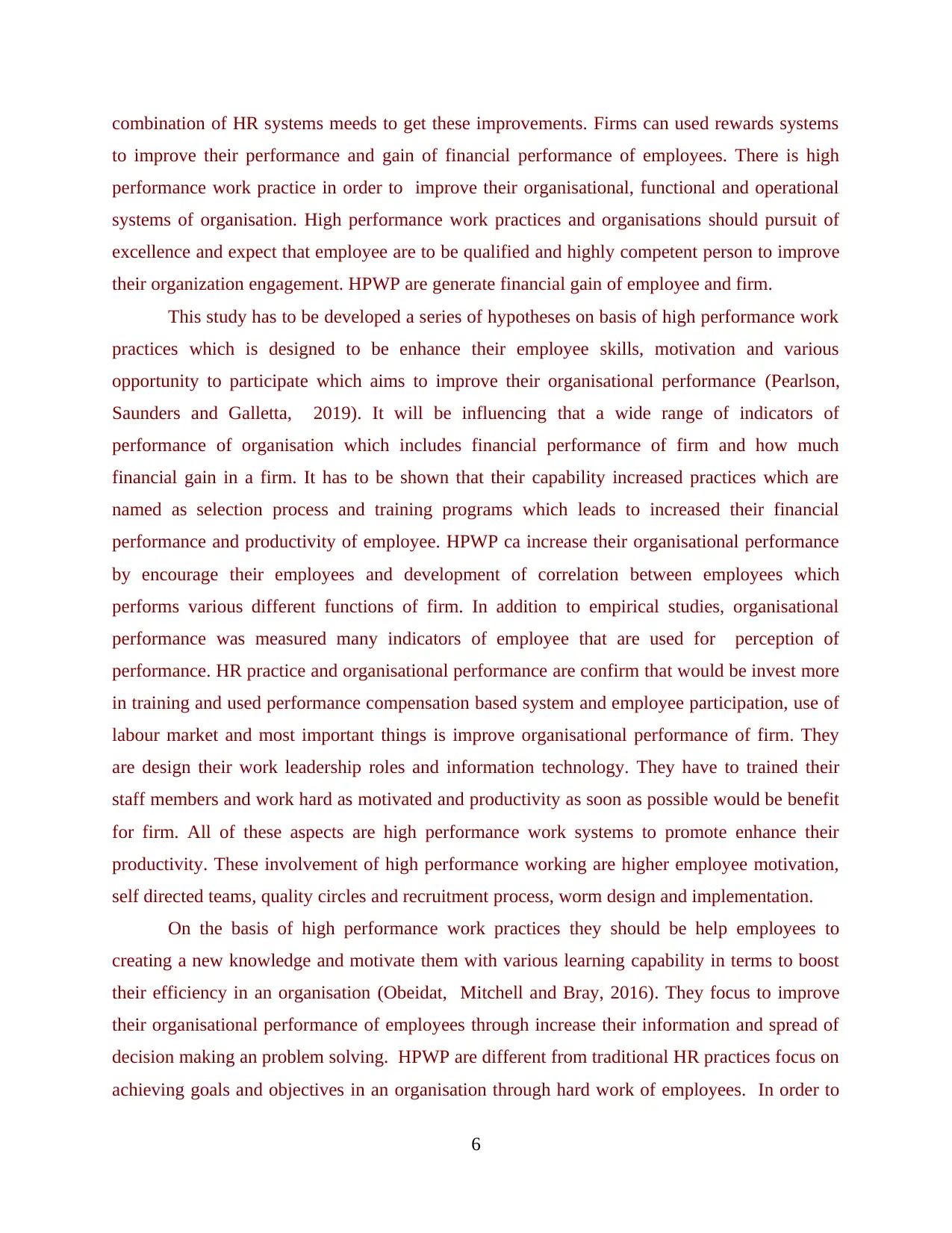
combination of HR systems meeds to get these improvements. Firms can used rewards systems
to improve their performance and gain of financial performance of employees. There is high
performance work practice in order to improve their organisational, functional and operational
systems of organisation. High performance work practices and organisations should pursuit of
excellence and expect that employee are to be qualified and highly competent person to improve
their organization engagement. HPWP are generate financial gain of employee and firm.
This study has to be developed a series of hypotheses on basis of high performance work
practices which is designed to be enhance their employee skills, motivation and various
opportunity to participate which aims to improve their organisational performance (Pearlson,
Saunders and Galletta, 2019). It will be influencing that a wide range of indicators of
performance of organisation which includes financial performance of firm and how much
financial gain in a firm. It has to be shown that their capability increased practices which are
named as selection process and training programs which leads to increased their financial
performance and productivity of employee. HPWP ca increase their organisational performance
by encourage their employees and development of correlation between employees which
performs various different functions of firm. In addition to empirical studies, organisational
performance was measured many indicators of employee that are used for perception of
performance. HR practice and organisational performance are confirm that would be invest more
in training and used performance compensation based system and employee participation, use of
labour market and most important things is improve organisational performance of firm. They
are design their work leadership roles and information technology. They have to trained their
staff members and work hard as motivated and productivity as soon as possible would be benefit
for firm. All of these aspects are high performance work systems to promote enhance their
productivity. These involvement of high performance working are higher employee motivation,
self directed teams, quality circles and recruitment process, worm design and implementation.
On the basis of high performance work practices they should be help employees to
creating a new knowledge and motivate them with various learning capability in terms to boost
their efficiency in an organisation (Obeidat, Mitchell and Bray, 2016). They focus to improve
their organisational performance of employees through increase their information and spread of
decision making an problem solving. HPWP are different from traditional HR practices focus on
achieving goals and objectives in an organisation through hard work of employees. In order to
6
to improve their performance and gain of financial performance of employees. There is high
performance work practice in order to improve their organisational, functional and operational
systems of organisation. High performance work practices and organisations should pursuit of
excellence and expect that employee are to be qualified and highly competent person to improve
their organization engagement. HPWP are generate financial gain of employee and firm.
This study has to be developed a series of hypotheses on basis of high performance work
practices which is designed to be enhance their employee skills, motivation and various
opportunity to participate which aims to improve their organisational performance (Pearlson,
Saunders and Galletta, 2019). It will be influencing that a wide range of indicators of
performance of organisation which includes financial performance of firm and how much
financial gain in a firm. It has to be shown that their capability increased practices which are
named as selection process and training programs which leads to increased their financial
performance and productivity of employee. HPWP ca increase their organisational performance
by encourage their employees and development of correlation between employees which
performs various different functions of firm. In addition to empirical studies, organisational
performance was measured many indicators of employee that are used for perception of
performance. HR practice and organisational performance are confirm that would be invest more
in training and used performance compensation based system and employee participation, use of
labour market and most important things is improve organisational performance of firm. They
are design their work leadership roles and information technology. They have to trained their
staff members and work hard as motivated and productivity as soon as possible would be benefit
for firm. All of these aspects are high performance work systems to promote enhance their
productivity. These involvement of high performance working are higher employee motivation,
self directed teams, quality circles and recruitment process, worm design and implementation.
On the basis of high performance work practices they should be help employees to
creating a new knowledge and motivate them with various learning capability in terms to boost
their efficiency in an organisation (Obeidat, Mitchell and Bray, 2016). They focus to improve
their organisational performance of employees through increase their information and spread of
decision making an problem solving. HPWP are different from traditional HR practices focus on
achieving goals and objectives in an organisation through hard work of employees. In order to
6
⊘ This is a preview!⊘
Do you want full access?
Subscribe today to unlock all pages.

Trusted by 1+ million students worldwide
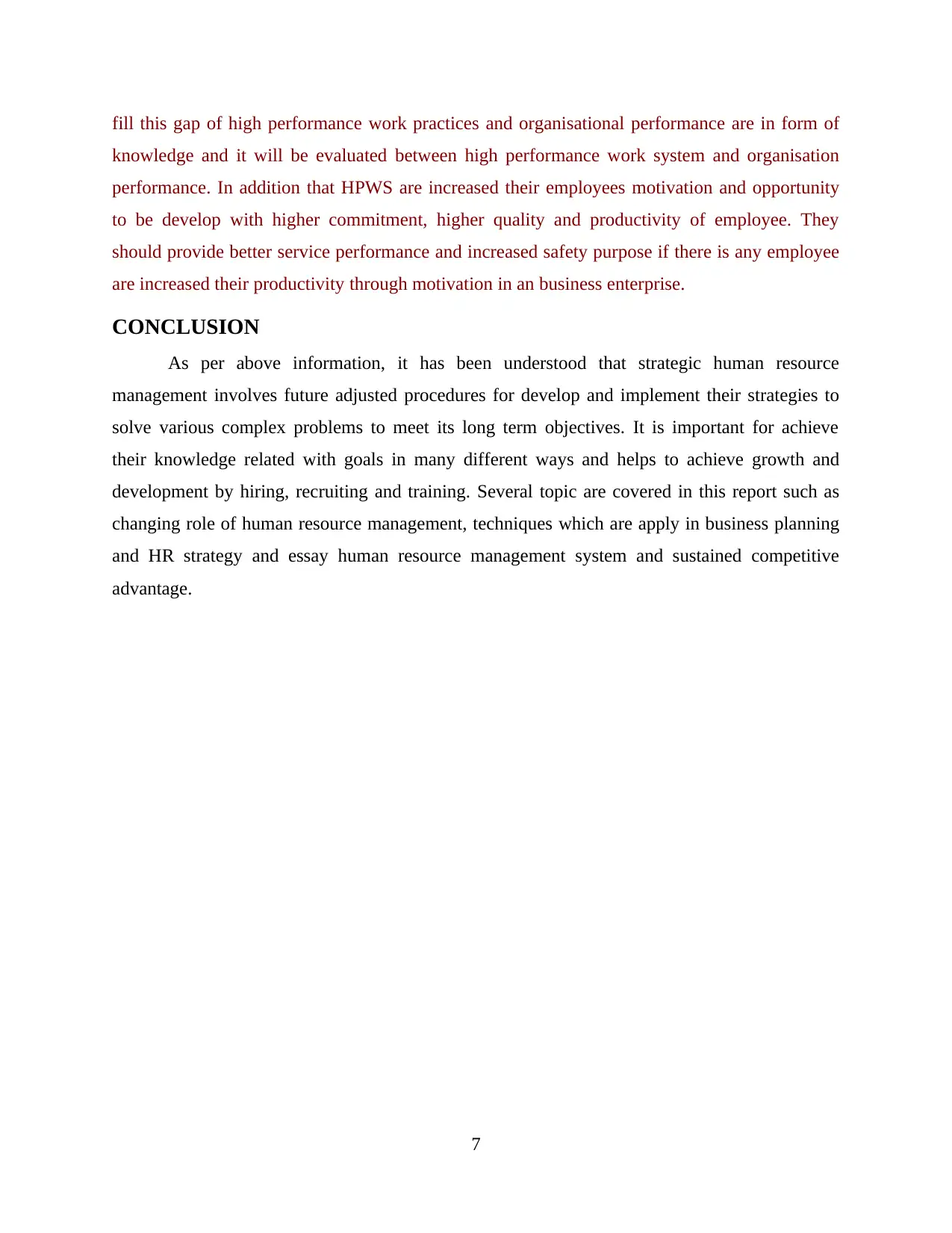
fill this gap of high performance work practices and organisational performance are in form of
knowledge and it will be evaluated between high performance work system and organisation
performance. In addition that HPWS are increased their employees motivation and opportunity
to be develop with higher commitment, higher quality and productivity of employee. They
should provide better service performance and increased safety purpose if there is any employee
are increased their productivity through motivation in an business enterprise.
CONCLUSION
As per above information, it has been understood that strategic human resource
management involves future adjusted procedures for develop and implement their strategies to
solve various complex problems to meet its long term objectives. It is important for achieve
their knowledge related with goals in many different ways and helps to achieve growth and
development by hiring, recruiting and training. Several topic are covered in this report such as
changing role of human resource management, techniques which are apply in business planning
and HR strategy and essay human resource management system and sustained competitive
advantage.
7
knowledge and it will be evaluated between high performance work system and organisation
performance. In addition that HPWS are increased their employees motivation and opportunity
to be develop with higher commitment, higher quality and productivity of employee. They
should provide better service performance and increased safety purpose if there is any employee
are increased their productivity through motivation in an business enterprise.
CONCLUSION
As per above information, it has been understood that strategic human resource
management involves future adjusted procedures for develop and implement their strategies to
solve various complex problems to meet its long term objectives. It is important for achieve
their knowledge related with goals in many different ways and helps to achieve growth and
development by hiring, recruiting and training. Several topic are covered in this report such as
changing role of human resource management, techniques which are apply in business planning
and HR strategy and essay human resource management system and sustained competitive
advantage.
7
Paraphrase This Document
Need a fresh take? Get an instant paraphrase of this document with our AI Paraphraser
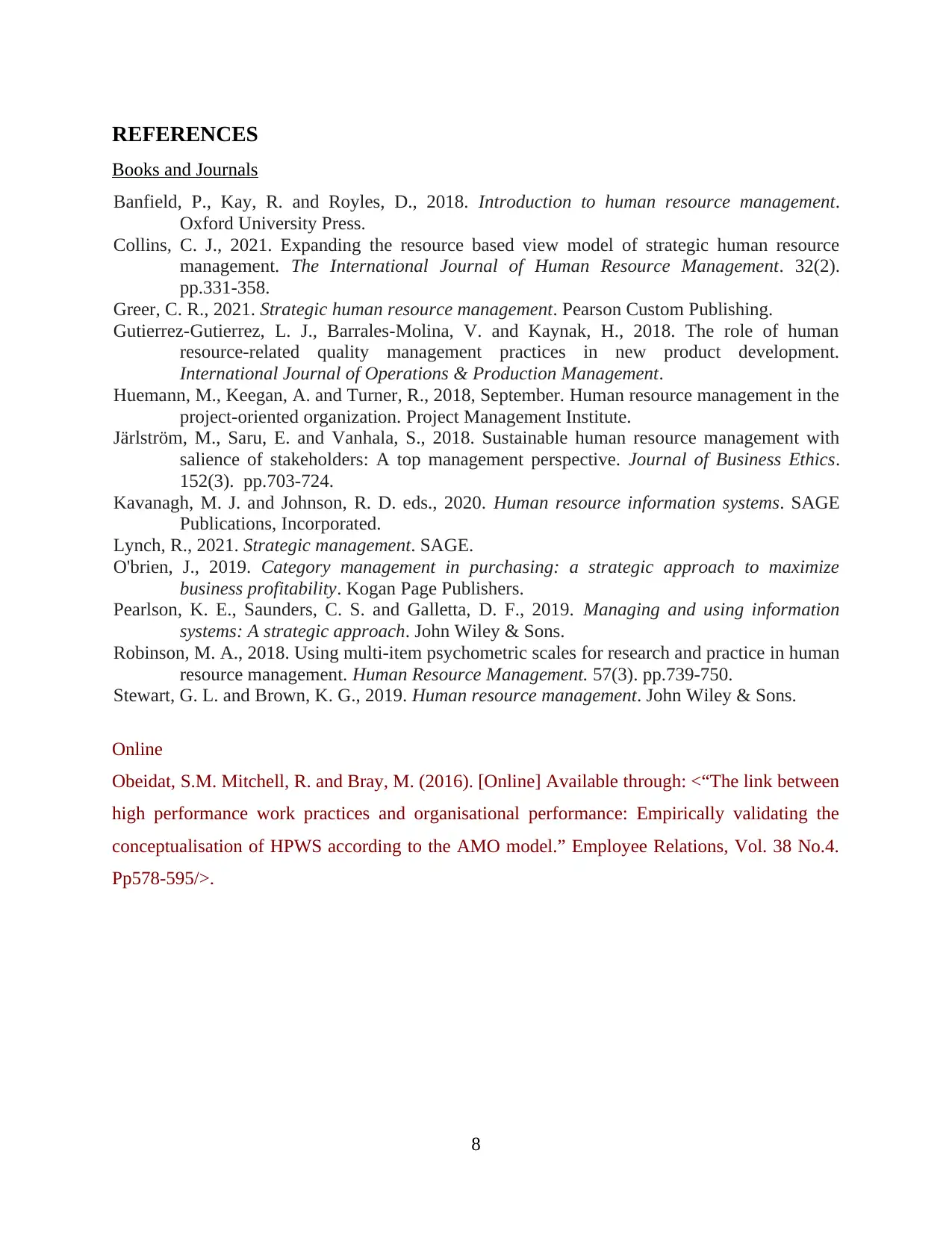
REFERENCES
Books and Journals
Banfield, P., Kay, R. and Royles, D., 2018. Introduction to human resource management.
Oxford University Press.
Collins, C. J., 2021. Expanding the resource based view model of strategic human resource
management. The International Journal of Human Resource Management. 32(2).
pp.331-358.
Greer, C. R., 2021. Strategic human resource management. Pearson Custom Publishing.
Gutierrez-Gutierrez, L. J., Barrales-Molina, V. and Kaynak, H., 2018. The role of human
resource-related quality management practices in new product development.
International Journal of Operations & Production Management.
Huemann, M., Keegan, A. and Turner, R., 2018, September. Human resource management in the
project-oriented organization. Project Management Institute.
Järlström, M., Saru, E. and Vanhala, S., 2018. Sustainable human resource management with
salience of stakeholders: A top management perspective. Journal of Business Ethics.
152(3). pp.703-724.
Kavanagh, M. J. and Johnson, R. D. eds., 2020. Human resource information systems. SAGE
Publications, Incorporated.
Lynch, R., 2021. Strategic management. SAGE.
O'brien, J., 2019. Category management in purchasing: a strategic approach to maximize
business profitability. Kogan Page Publishers.
Pearlson, K. E., Saunders, C. S. and Galletta, D. F., 2019. Managing and using information
systems: A strategic approach. John Wiley & Sons.
Robinson, M. A., 2018. Using multi‐item psychometric scales for research and practice in human
resource management. Human Resource Management. 57(3). pp.739-750.
Stewart, G. L. and Brown, K. G., 2019. Human resource management. John Wiley & Sons.
Online
Obeidat, S.M. Mitchell, R. and Bray, M. (2016). [Online] Available through: <“The link between
high performance work practices and organisational performance: Empirically validating the
conceptualisation of HPWS according to the AMO model.” Employee Relations, Vol. 38 No.4.
Pp578-595/>.
8
Books and Journals
Banfield, P., Kay, R. and Royles, D., 2018. Introduction to human resource management.
Oxford University Press.
Collins, C. J., 2021. Expanding the resource based view model of strategic human resource
management. The International Journal of Human Resource Management. 32(2).
pp.331-358.
Greer, C. R., 2021. Strategic human resource management. Pearson Custom Publishing.
Gutierrez-Gutierrez, L. J., Barrales-Molina, V. and Kaynak, H., 2018. The role of human
resource-related quality management practices in new product development.
International Journal of Operations & Production Management.
Huemann, M., Keegan, A. and Turner, R., 2018, September. Human resource management in the
project-oriented organization. Project Management Institute.
Järlström, M., Saru, E. and Vanhala, S., 2018. Sustainable human resource management with
salience of stakeholders: A top management perspective. Journal of Business Ethics.
152(3). pp.703-724.
Kavanagh, M. J. and Johnson, R. D. eds., 2020. Human resource information systems. SAGE
Publications, Incorporated.
Lynch, R., 2021. Strategic management. SAGE.
O'brien, J., 2019. Category management in purchasing: a strategic approach to maximize
business profitability. Kogan Page Publishers.
Pearlson, K. E., Saunders, C. S. and Galletta, D. F., 2019. Managing and using information
systems: A strategic approach. John Wiley & Sons.
Robinson, M. A., 2018. Using multi‐item psychometric scales for research and practice in human
resource management. Human Resource Management. 57(3). pp.739-750.
Stewart, G. L. and Brown, K. G., 2019. Human resource management. John Wiley & Sons.
Online
Obeidat, S.M. Mitchell, R. and Bray, M. (2016). [Online] Available through: <“The link between
high performance work practices and organisational performance: Empirically validating the
conceptualisation of HPWS according to the AMO model.” Employee Relations, Vol. 38 No.4.
Pp578-595/>.
8
1 out of 11
Related Documents
Your All-in-One AI-Powered Toolkit for Academic Success.
+13062052269
info@desklib.com
Available 24*7 on WhatsApp / Email
![[object Object]](/_next/static/media/star-bottom.7253800d.svg)
Unlock your academic potential
Copyright © 2020–2025 A2Z Services. All Rights Reserved. Developed and managed by ZUCOL.





